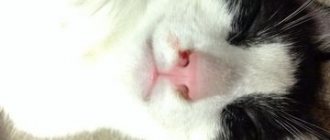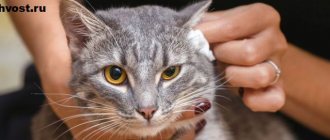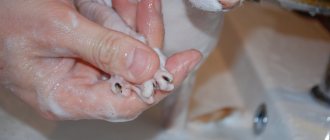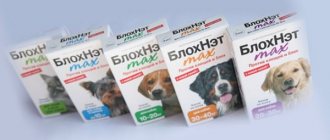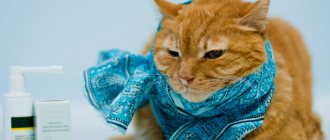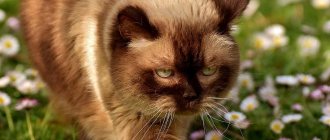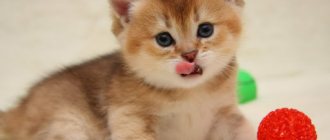Causes of "cat" snot
Rhinitis (inflammation in the nasal passages) occurs in cats due to the impact of various unfavorable factors on the nasal mucosa.
Because of this, special glands begin to secrete a special protective secretion in much larger quantities than usual. We are accustomed to calling this secretion - a mucous liquid secreted from the nostrils - snot. Reasons for nasal discharge:
- colds due to hypothermia (despite the popular belief that cats do not get colds, this illness is still common to them - sleeping in a draft, feeding cold foods and milk, staying in the cold for a long time, etc.);
- allergies (food reactions or local manifestations of the influence of household chemicals (for example, powders), medications or treatments for parasites, etc.);
- foreign bodies getting stuck in the nasal passages;
- viral or bacterial infections, fungi (rinotracheitis, plague (panleukopenia), pneumonia, calicivirosis, mycoplasmosis, etc.);
- presence of parasites in the nose;
- inflammation of the ears;
- congenital curvature of the nasal septum;
- tumors and other neoplasms;
- exposure of the nose to hot or cold air.
What to pay attention to
The symptoms of rhinitis directly depend on the cause that caused it. Basically the following can be observed:
- snot itself - of varying consistency and color (watery, slimy or thick; transparent, yellowish-gray or green), and a change in the shade of mucus secreted from the nose (green or yellow-green) is almost always a sign of a bacterial infection;
- lacrimation and sourness of the eyes (the nasal cavities are connected to the lacrimal canals, so very often tears are associated with a runny nose);
- the mucous membrane of the nasal passages swells and turns red, this makes breathing difficult and wheezing appears;
- the pet sneezes (snorts) and periodically rubs its face with its paws;
- in the presence of tumors, the muzzle may become asymmetrical, various curvatures may appear;
- nasal congestion is manifested by mouth breathing - this is clearly visible in the swelling of the cheeks;
- of the general symptoms of malaise: the temperature may rise, lethargy, apathy may appear, appetite decreases or disappears.
In addition to the main symptoms, for a more accurate diagnosis, you should prepare the following information for the veterinarian:
- Nature of discharge: constantly or exclusively in the evenings/mornings/after increased activity, in what body position.
- Flow abundantly or scanty and smeared.
- Do they dry out, forming crusts, or is the nose constantly wet?
- Both nostrils or one are involved in the process.
- When an animal sleeps, its mouth is open or closed.
- Is the cat bothered by a runny nose or does he not pay attention to the condition?
In what cases is the help of a veterinarian needed?
- Sneezing and nasal discharge for 3 or more days.
- Intensive deterioration of the condition - the cat sneezes more often, the nose runs more strongly.
- The color and/or consistency of nasal discharge changes.
- Green, yellow, black, or bloody nasal discharge.
- Itching in the muzzle area.
- Noisy or hoarse breathing, snoring.
- Decreased appetite and activity level.
- Vomit.
- Photophobia.
- Fever.
- Anemia of the mucous membranes.
- Noticeable deterioration in wool quality.
- The appearance of crusts, cracks, scabs on the skin of the nose.
- Discharge from the eyes.
How to help a pet with snot
If you notice any discharge from your cat's nose, you should definitely consult a veterinarian. Without establishing the exact cause, it will not be possible to help the animal. Self-medication is not advisable, because only a specialist can determine the cause and tell you what to do if your cat has snot. This problem can only be eliminated if the root cause is eliminated. Only a specialist can tell you how to treat a runny nose in a cat!
Allergy
Treating allergies is usually a long and difficult process. It is imperative to eliminate exposure to the suspected allergen, otherwise therapy will be ineffective. Allergy snot is usually liquid and transparent; nasal rinsing is not required. Depending on the type of allergen, antihistamines are prescribed (clemastine, tavegil - ½ tablet per animal every 12 hours; cetirizine - 0.5-1 mg/kg once a day or the same dose divided into two doses every 12 hours).
Cold
If it becomes known that Murka has a cold, then it is recommended to apply cloth bags with heated sand or salt to the bridge of the nose to warm it up (if the snot is yellow or green, warming up is prohibited).
Rinse with a 3% solution of boric acid, 1% solution of zinc sulfate (ready-made pharmaceutical solutions), 1% solution of sea salt or saline solution.
Drip ecmonovocillin daily, 3-4 drops into each nostril (previously diluted 1:2 in saline) or blow fine streptocide powder into the nose (you can use a small rubber bulb).
Infection
First of all, the veterinarian determines the type of infection: viral, fungal or bacterial. Antiviral, antifungal drugs and/or antibiotics are prescribed. General restoratives must be prescribed. As a rule, the snot disappears almost within the first days after the start of therapy.
Rinsing the nose is indicated only in cases where the nasal discharge is thick and it becomes difficult for the pet to breathe. When the color of the snot changes to yellow-green, the same drugs are used for treatment as for a cold.
If the discharge is clear, but there is swelling and the animal is breathing through the mouth (you can see how the cheeks are swollen), children's vasoconstrictor drops are recommended - galazolin (twice a day, 2-4 drops in each nostril).
Thymogen drops have proven themselves to be effective in increasing local mucosal immunity during viral infections (individuals weighing up to 5 kg, 1 drop once a day for 10 days).
Tumors, polyps
The nature, size and type of tumor can only be determined by a specialist. If, in addition to snot, the animal clearly has difficulty breathing and there is deformation of the muzzle, then the only correct solution will be surgical intervention to remove the tumor.
Additional examinations of the general condition of the cat are required to make a decision on the operation. Rhinitis usually goes away after the tumors are removed.
Foreign object
Cats have very narrow nasal passages, so the owner is unlikely to notice anything foreign in the pet’s nose. A characteristic sign that something has gotten into the nose will be mucus secreted from only one nostril, hoarse breathing on that side (or the absence of signs of air movement at all along this nasal passage) and the pet’s constant attempts to rub its nose, supposedly to get rid of something. then an outsider.
If you suspect that your nose is blocked by foreign objects, you should seek help from a specialist. The foreign element will be removed, you may have to rinse your nose with normal saline for a couple of days and the runny nose will stop.
Parasites
The presence of parasites is also difficult to notice on your own. The main signs are similar to those when an animal has a foreign object in its nose, but the discharge can come from both nostrils. Only when a veterinarian examines the nasal cavities can helminths, ticks, or crawling fleas be detected. The nasal cavity is cleaned mechanically, appropriate treatments are carried out to remove skin parasites and worms, and it is washed with saline solution for 1-2 days.
Local reaction to irritants
The cat could climb into the bag of powder and sniff it, or stick its head into a container with strong-smelling solutions. The reaction will be similar to an allergic one - lacrimation and clear, liquid snot.
It is necessary to rinse the nasal passages as quickly as possible with saline solution, homemade solution of table salt (1/2 tsp per 0.5 liter of boiled water), furacillin and give an antihistamine (cetirizine - daily dose up to 1 mg/kg; tavegil, clemastine - according to half a tablet twice a day at equal intervals).
After several washes, it is permissible to use vasoconstrictor drops to relieve swelling (galazolin - 2-4 drops twice a day).
Otitis
In addition to the fact that the animal will have snot and tears, there will clearly be a noticeable sore ear pressed to the head. The cat may meow and show anxiety. It is necessary to eliminate the primary disease – otitis media. Treatment is prescribed only by a veterinarian.
Treatment of the nasal cavity should be carried out by analogy with a cold and taking into account the nature of the snot (liquid or thick, transparent or cloudy, green-yellow).
General strengthening
Regardless of the cause of the runny nose, it will not be superfluous to use general strengthening and immunostimulating agents. For example:
- gamavit (from 0.3 to 0.5 ml/kg once a day a week 1-3 times; course - 2-4 weeks);
- fosprenil (no more than 0.3 ml/kg body weight into the muscle or subcutaneously; double the dosage if given orally; course - up to 1 week);
- immunofan (intramuscularly or into the withers under the skin in a volume of 1 ml once a day, course – 5-7 days);
- ribotan (0.5-2 ml per animal once a day for 3-5 days).
Mr. Cat recommends: features of treating a runny nose in a kitten
A kitten's growing body requires more careful attention when dealing with a runny nose. First of all, it is necessary to improve the living conditions and nutrition of the small pet.
For a speedy recovery, you can do inhalations using eucalyptus oil: you need to add a few drops of oil to a container of hot water, then turn the kitten’s head towards it so that it can inhale the vapors, and cover it with a napkin.
Here you should be careful not to burn your pet.
The warming up procedure will also be useful. To do this, you can use bags of salt or sand.
We recommend reading: Why the Kitten Doesn’t Eat and Vomits After a Diet
To ease breathing, children's drops are suitable: Aqua Maris, Pinosol.
Question answer
What makes a cat snot and drool?
If at the same time there is an increase in temperature and lacrimation, then these signs most often belong to feline distemper or panleukopenia. This is a viral infection, terrible because it significantly weakens the animal’s body and a secondary bacterial infection immediately joins the process. Treatment most often consists of suppressing microbial activity and restorative therapy. It is very important to consult a veterinarian with such symptoms!
How to wash out snot from a cat's nose?
A solution of the product that is planned to be used for washing is prepared and brought to body temperature. This can be a saline solution (saline solution) or any other medicine.
The cat must be immobilized to protect itself from potential scratches. To do this, it is enough to wrap the animal in a thin blanket or harsh towel up to neck level. Be sure to talk to her gently in order to relax the cat as much as possible during the procedure.
Start slowly pouring the prepared solution into each nostril from a syringe (without a needle!) - no more than 0.5 ml. It is better if the syringe is insulin - it is more convenient to dose. Blot the leaking liquid with a napkin. The cat will snort and sneeze - this is good and helps remove deeper mucus. After the end of snorting and sneezing, the second nasal passage is washed in the same way.
How can you wash a cat's nose if he has snot?
You can rinse your mustachioed pet’s nose with the following solutions:
- 0.9% saline solution;
- homemade saline solution (1 teaspoon of salt is dissolved in 1 liter of boiling water, boiled for 1-2 minutes, filtered through cheesecloth, cooled);
- 2-3% solution of boric acid;
- 0.5% tannin solution;
- 0.5-1% solution of zinc sulfate;
- furacillin solution (1 tablet per 1 glass (250 ml) of warm boiled water);
- 0.5% solution of dioxidine (1% pharmaceutical form is diluted 1:1 with boiled water);
- 1% soda solution (1/2 tsp baking soda per 0.5 liters of warm boiled water).
The number of washes, volumes and, most importantly, the type of solution is selected only by a veterinary specialist!
If a cat has watery eyes and rhinitis – what is it?
Options: development of allergies, colds or infection with a viral/bacterial infection of the upper respiratory tract (rinotracheitis, panleukopenia, calicivirosis, etc.) or eyes (conjunctivitis). It is important to pay attention to whether there are any other accompanying symptoms that can help differentiate the exact cause of rhinitis.
What is wrong with a cat if she sneezes and has snot?
Options range from a common cold to various types of infections. The presence of parasites inside cannot be ruled out. It is necessary to pay attention to accompanying signs - temperature, general condition, lacrimation, etc. and be sure to contact your veterinarian for advice. If the mucus is green, this is a sign of microbial activity in the nasal cavity.
The cat has a runny nose in only one nostril.
Most likely the animal got something into its nasal passage. In case of any internal diseases accompanied by rhinitis, discharge is observed simultaneously from both nostrils - a distinctive feature. You need to carefully examine the part of the nose where the snot comes from, and if it is not possible to provide help at home, go to a veterinary hospital for qualified help.
Is a runny nose in a cat contagious to humans?
Cat snot itself and the causes that cause it do not pose a danger to humans. This fact does not exclude compliance with sanitary rules when assisting a pet - mandatory hand washing after contact or the use of rubber medical gloves.
If a cat has a runny nose, what should the owner do?
The right decision would be not to engage in amateur activities, but to seek advice from a veterinary clinic, and also follow the veterinarian’s further recommendations. A seemingly harmless runny nose can be a sign of a serious infectious disease.
Grinchuk Ekaterina Andreevna veterinarian
Causes of nasal discharge
Clear discharge in an animal cannot be caused by a cold, since animals simply do not get sick from it. Your cat may have clear fluid coming from his nose due to:
- Poor nutrition. The lack of vitamins, essential microelements and nutrients leads to weakened immunity in cats. The pet needs to eat a balanced diet at the same time;
- Infections. If the immune system is weakened, the virus easily penetrates the pet’s body, undermining its health;
- Poor living conditions. High air humidity and low room temperature can trigger the disease. The most comfortable temperature for a pet is 22 ⁰ C. The animal also gets sick after hypothermia and long walks in winter or in the rain. To prevent this from happening, you need to wipe the cat with a terry towel.
Most often, animals get sick due to a virus that has entered the body. If a cat’s eyes and nose are running (eye festering), then he has definitely caught the virus.
“Feline distemper” or panleukopenia is another terrible disease of cats. The heart, respiratory system, and gastrointestinal tract are affected. The cat suffers from severe intoxication and dehydration. The disease occurs with a high temperature of up to 41 o C, yellow-green vomiting, diarrhea, conjunctivitis, and rhinitis. Animals often stand over a bowl of water, but do not drink due to severe abdominal pain.
Rhinitis can also cause congenital nasal defects. Some breeds of cats may have discharge from the nose and eyes not related to the disease, but related to the anatomy of the animal, for example, Persian extreme cats. Some parasitic diseases cause rhinitis (toxoplasmosis).
If the discharge becomes purulent, you need to use antibacterial agents.
Nasal discharge (discharge of mucus or pus from the nose) in an animal is an attempt by its body to get rid of a pathogen or allergen. Often, secretion from the nose is accompanied by sneezing, impaired nasal breathing, and the cat may open its mouth slightly to breathe. The animal often licks its nose and the area around it. The fur near the nose becomes damp. Nasal secretions may contain blood.
Prevention
The pet is protected from irritants - dust, tobacco smell, perfumes. Provide balanced nutrition. If a felinologist does not have the skills to prepare a diet from natural products, it is better to use factory-made food. To avoid contracting cat flu, your pet is vaccinated in a timely manner.
Discharge of clear fluid from the nose indicates that a foreign object has entered the nostrils, an allergic reaction, or a contagious disease. If an alarming symptom occurs, contact a veterinarian. You cannot treat the disease yourself with human medications, as well as folk remedies.
Types and signs of nasal discharge
- mucopurulent;
- bloody;
Mucous discharge is a clear discharge, quite liquid (not too viscous). Such discharge may be a sign of an allergy and the entry of a fine substance into the animal’s nose, causing mechanical irritation of the mucous membrane. The secretion of the mucous membrane may contain leukocytes and microparticles that cause irritation.
In young kittens, pus in the nasal secretions can appear due to poor care, the absence of a mother, and significant dietary errors.
Transparent discharge flowing from one nostril may be a sign of a foreign object entering the nasal passage. If the object is large or sharp, the discharge may be mixed with blood; if the object is in the sinus for a long time, a bacterial infection may occur. The general condition of the pet is slightly impaired.
Allergic rhinitis is accompanied by frequent sneezing of the animal and the discharge of clear mucous discharge, often in large quantities.
Infection with fungi (most often cryptococcosis), brain tumors that collapse or grow into the nose, and chronic infections caused by bacteria cause the destruction of nasal membranes. This leads to the flow of mucopurulent secretion mixed with blood from one or both nasal passages.
A severe respiratory disease in cats caused by a herpes virus is called rhinotracheitis. It is accompanied by many symptoms: general (lethargy, fatigue, drowsiness, refusal to eat) and specific (purulent discharge from the eyes and nose, sneezing). Pneumonia may develop in weakened animals, and self-abortion may occur in pregnant cats.
Another common infectious disease that is dangerous for cats is calcivirus. It is characterized by copious discharge from the nose and eyes, initially mucous, then serous, then purulent, foul-smelling discharge. The cat begins to develop hypersalivation, fever (up to 40.5 o C), and ulcerations appear on the mucous membranes of the mouth, lips, and tongue. The animal refuses food, diarrhea may develop, followed by constipation.
If pus or blood appears in your cat's nasal discharge, you should definitely show him to a veterinarian. To make it easier for an animal to breathe before going to the hospital, its nasal passages need to be cleared of crusts; this can be done with cotton wool pads and baby oil. You can soak the crusts using saline or boric acid (2% solution can be purchased at the pharmacy).
If a cat has an allergy, you need to try to find out what substance caused it and stop the cat's contact with the allergen. Wet cleaning of the room and humidification of the air will help make nasal breathing easier for your animal; you can take your cat with you to the bathroom. While you take a shower or bathe, the cat will breathe moist air.
The disease, its course and symptoms
In order to cure a kitten with snot, you need to contact a specialist.
This problem cannot be left to chance; for kittens, the concept “it will go away on its own” is unacceptable.
For a correct diagnosis of the cause and, as a result, the correct treatment of a runny nose, the fact of the presence of sniffles will not be enough for the doctor. From the moment the kitten starts snot, you need to monitor it very carefully. You will need to know what kind of stool he has, his appetite, activity and other features of his behavior. The more and more accurate data you can provide, the sooner doctors will be able to cure your pet.
During the period of illness, the kitten will need your attention and care. It is advisable to create the most comfortable conditions for him:
- Peace and comfort. Make him a warm place, maybe even cover him with a blanket.
- Don't force feed. Due to nasal congestion, the animal does not smell food, and they will not eat food without smell. If possible, offer him sardines, tuna, or other foods with a strong smell.
- Care. If possible, wipe away nasal discharge.
If a kitten has snot and is not treated promptly, complications such as discharge from the eyes may develop. Moreover, the discharge turns from transparent to purulent - green, and sometimes even mixed with blood.
The snot of a little kitten is not as harmless as it seems at first glance. A small organism does not yet have all the protective properties and the necessary strength to fight the disease. Therefore, it is so important to take this disease seriously and seek help from a veterinary clinic. The doctor may immediately make a diagnosis or ask you to take several tests to clarify it. The treatment tactics and the necessary medications depend on the diagnosis.
Medicines can be simple anti-inflammatory or antiviral, and sometimes even antibiotics are required.
There are situations when a kitten has bloody snot and then it is necessary to first stop the bleeding, and only then treat the snot itself. In some cases, the blood does not carry any terrible symptoms, but is a consequence of stress, excessive sneezing, or a foreign object getting into the nose.
But sometimes bloody discharge can indicate an infection. In the first case, the bloody impurity will disappear within a short time, but if this does not happen, and blood continues to be present in the kitten’s snot for several days, then you need to immediately contact the clinic and go for tests. You may need eye and nasal swabs, blood tests, or even an x-ray.
Summarizing all of the above, several main conclusions can be drawn.
- Kittens are much more likely to have a runny nose due to undeveloped immunity. Therefore, it is worth monitoring your furbabies more closely. Do not let them stay in the cold for a long time; after swimming or walking in the rain, wipe them dry; do not let them freeze. Monitor their diet and include as much dairy and meat products as possible.
- If you notice that your kitten has snot and purulent eyes or just a runny nose, you should not try to cure it yourself. By giving an animal any medicine at your own discretion or on the advice of friends, you will only blur the overall picture of the disease. Which in the future will only prevent the doctor from making a correct diagnosis.
Viral or respiratory diseases in cats
Thick and mucous discharge is a sign of a respiratory infection. It is important to understand that there are a lot of such infections and the diagnosis must be made by a veterinarian.
Viral diseases of cats that cause rhinitis:
- Actinomycosis.
- Viral peritonitis.
- Hemobartonellosis.
- Viral immunodeficiency.
- Calicivirus.
- Giardiasis.
- Mycoplasmosis.
- Panleukopenia (distemper).
- Parvovirus.
- Rhinotracheitis or herpes virus infection.
- Chlamydia.
A bacterial infection can cause chronic nasal discharge. If the discharge is thick, yellow and has an unpleasant odor - a bacterial infection, this is the most likely diagnosis.
How to treat colds in cats?
Let us repeat once again that the most correct action for a cat owner when symptoms of a runny nose appear is to contact a veterinarian. Without laboratory tests, it is impossible to determine the cause of the disease and prescribe the correct treatment.
- If a cat has a cold caused by malnutrition and poor living conditions, then you must first eliminate the causes that provoked the disease. Next, you need to eliminate the animal’s nasal irritation. Warming up with hot sand will help with this. This procedure needs to be done three times a day.
- If a veterinarian has diagnosed infectious rhinitis in a cat, then gasoline drops can be used for treatment. You can drip from 5 to 10 drops at a time.
- In chronic forms of runny nose, the skin of the animal’s nose becomes irritated and constantly becomes wet. You can cope with the problem using white streptocide powder. You need to sprinkle it on the nose of a sick cat a couple of times a day.
- When a pet sleeps well, eats well, and is in a great mood, but there is mucus discharge from the nose, this may be a sign of irritation of the mucous membrane. You can cope with the problem by rinsing your nose with a weak solution of dioxidine.
Otherwise, treatment of runny nose in cats is symptomatic.
Allergies and mucosal irritation
Light, clear snot, sneezing and watery eyes are all symptoms of an allergic reaction in pets. Hypersensitivity can be caused by both food and external irritants. Common allergens:
- Household chemicals.
- Flea shampoos.
- Preparations for antiparasitic treatment.
- Dust and plant pollen.
Treatment begins with identifying the stimulus. If you succeed in identifying the allergen and eliminating its effect, you don’t have to worry - the animal will no longer encounter such a disease. As a rule, after the irritant ceases, the symptoms of rhinitis quickly subside and completely disappear within a few days.
If the allergen cannot be identified, and the pet’s condition worsens every day, drug therapy is necessary. In particularly severe cases, the cat will have to take antihistamines for life.
You might be interested in: Bald patches in a cat: how to distinguish normal from pathology?
What are the consequences of a cold in cats?
Like other warm-blooded animals, a cold in cats can lead to serious consequences. A seemingly mild illness can provoke the development of pneumonia, cause rheumatoid joint damage, and lead to kidney disease.
If a cat has a runny nose and is sneezing, then this means one thing – the animal’s immunity is reduced. His body is not able to cope with serious infectious diseases. Any contact with a pathogenic microbe or virus is likely to cause serious health problems and lead to the development of severe pathology. Therefore, it is very important to start treating your pet at the first sign of a cold.
It happens that a cat's nose runs for too long, and the runny nose becomes chronic. In this case, it is unlikely that the animal will be cured forever. In addition, the pet may become sad and less mobile. The following diseases can affect an animal's immune system:
- Viral rhinotracheitis;
- Calicevirosis;
- Adenovirus;
- Chlamydia.
Diseases begin with a harmless clear liquid. All this can end disastrously: after the disease begins to progress, the owner has about 5-10 days to save the animal.
Heavy clear discharge that does not stop for three days cannot be treated independently. This sign may be a symptom of a serious disease, which only a veterinarian can determine. The disease can also be dangerous and contagious for young children living in the home with a pet.
What if the problem is more serious?
A prolonged runny nose in animals can become chronic - in this case, pathogens can rarely be destroyed. Diseases significantly affect the condition of the animal.
- adenovirus;
- viral rhinotracheitis;
- chlamydia;
- feline calicevirus;
- plague in dogs - it begins with the appearance of liquid discharge from the nose that resembles water - so you should not wait until rhinitis ends on its own.
You can lose your pet within 5-10 days.
Allergic rhinitis is treated with corticosteroids and antihistamines. It is almost impossible to independently determine a treatment regimen and find out what dosage your pet needs.
If your pet dog or cat has profuse nasal discharge and does not go away for more than 3 days – “water is pouring” – you should definitely contact a veterinarian. By self-medicating, you can lose the animal.
In addition, some animal diseases can be dangerous to humans - this should be thought about first, especially when there are small children at home.
Unless you are a certified veterinarian, do not try to treat your pet yourself!
Do not try to rid him of his illness with “human” medicines. Remember, you are responsible for the life of this creature, so seek help from a specialist in a timely manner!
The cat's nose is running (clear water) Hello. Please tell me, my cat periodically (several times a day) has a clear, watery liquid flowing from her nose (not snot IMHO), her nose is cold, otherwise everything is as usual. It started about 3 weeks ago. We took him to the veterinarian, the temperature was normal, he said that it was an allergy to the food and advised him to switch to special food for sterilized animals. At first we fed Royal Canin for indoor cats that do not go outside, now we have changed it and give her Royal Canin for sterilized cats + canned food from the same company (just for adult cats), she drinks a normal amount of water. In general, everything is as usual. The veterinarian did not give any allergy injections, but they did give him the first shot of the vaccine. At the first appointment, the cat was injected with something so that it would not become infected at the veterinary clinic, because... not vaccinated (sorry, I don’t remember the name). I don’t want to take her to another clinic even further, the cat doesn’t tolerate travel well, she’s terribly nervous and the fur just starts to come out in clumps.
About the cat: I adopted a cat from an advertisement 1.5 months ago - a court terrier, approximately 2 years old, sterilized. It was not possible to communicate with the former owners, third people reported, because... They wanted to euthanize the cat because of the move. Therefore, I don’t even know what the cat was fed, etc. We took her to the vet for an examination, he said that the cat was healthy, but neglected. The fleas were removed, the claws were trimmed, and the scratches on the neck healed. The coat is so-so, a little dandruff and a little tangled. The doctor said to give her vitamins, but we’re not giving them very actively yet - she doesn’t want to take pills, I can’t get around to buying drops. 9 years The fact is that the veterinarian who was shown the cat was also worried at first that it was a cold. However, no fever, no discharge in the ears, no snot from the nose, but water. And the cat was vaccinated (first stage) against these diseases. The cat's condition has not changed at all. Of course, I’m not an expert, but I’m sure that vaccination will worsen the condition of a sick animal. Added 9 years ago
Causes
There are many reasons why a cat has a runny nose. Before you figure out what causes the release of mucous or purulent exudate from the nasal passages, you need to know what mucus is and what it is needed for. The role of mucus in the nasal passages is as follows:
- retention of foreign particles penetrating into the nasal cavities (various household dust, pathogenic bacterial microorganisms, fungi and viruses);
- creating the necessary humidity in the nasal sinuses to clean and regulate the heat of the air entering the lungs;
- disinfecting effect of viral and bacterial microorganisms penetrating from the environment (antiseptic is created due to the protein - mucin).
Physiological secretions of mucous exudate from the nasal passages contain protein components, water and various salts. Irritation of the mucous membrane due to a number of pathological factors provokes increased activity of cellular structures, which leads to a large amount of secretion that is not excreted properly. Rhinitis occurs, and the cat is leaking clear fluid.
Part of the secretion produced by the mucous glands exits through the nasal passages, and part passes down the nasopharynx.
Factors that indirectly influence the general appearance of nasal discharge are varied. The main ones are:
- type of inflammatory process;
- the presence of pathogenic microflora in secret;
- viscosity of mucous discharge.
Normal nasal discharge, thin and clear. Normally, they come out of the nasal passages on their own in small quantities, moisturizing it. This happens with the help of ciliated epithelium located on the mucous part. With pathological changes in the body, provoked by viruses, bacteria or allergens, the mucus becomes thick and its outflow is disrupted, clogging the nasal passages and causing swelling.
The type of inflammation in rhinitis can be catarrhal (it is characterized by the appearance of a large amount of clear liquid, without color and liquid consistency) and purulent (the cat has pus flowing from the nose). Purulent inflammatory processes are characterized by the appearance of thick, yellowish or greenish discharge. The color saturation and consistency of snot directly depends on the number of pathogenic microorganisms filling the nasal passages.
The main reasons for the development of a runny nose and nasal discharge in a cat are infectious diseases. Various viruses, fungi, protozoa and pathogenic bacteria cause not only rhinitis, but also other changes in the body. In the vast majority of cases, cats are diagnosed with calcivirus infection, rhinotracheitis, mycoplasmosis and chlamydia. Cryptococcal infections and asperegylosis are less common.
The lack of adequate treatment for the acute phase of rhinitis can provoke the further development of a chronic form of a bacterial nature. Treatment of chronic bacterial rhinitis is quite problematic and requires a special approach.
Other causes of nasal discharge in cats include:
- Nasopharyngeal polyps. Specific growths in the nasal passages that provoke disturbances in the act of swallowing, normal nasal breathing becomes difficult, and chronic sneezing occurs. It is diagnosed more often in cats at a young age. The cause of the development of polyps is considered to be inflammatory processes of bacterial origin in the middle ear.
- Tumor processes in the oral cavity and nose. Old cats that are diagnosed with lymphosarcoma, fibrosarcoma or adenocarcinoma are susceptible to developing tumors in the nose and mouth. A sign of a malignant neoplasm is that the cat has bleeding from the nose, severe swelling in the muzzle, and visual deformation of the nasal septum.
- Stuck foreign body. An object entering the animal's nose blocks the passages and causes a blockage. As a result of mechanical impact, swelling of the nasal cavity occurs and copious discharge appears. Thus, with the help of secreted secretions, the body tries to get rid of the foreign object.
- Congenital anomalies. In some cases, if there is a violation in embryonic development, the cause of discharge from the cat’s nose is a cleft palate, cleft lip, or deformation of the nasal septum.
- Mechanical injuries to the skull and jaw. As a result of displacements of bone structures, the development of chronic rhinitis is possible.
It is not possible to identify the true cause of the development of rhinitis on your own. You need to contact a veterinarian. Only in a veterinary hospital is it possible to establish an accurate diagnosis.
The specialist conducts a general examination, establishing the nature of the discharge - hemorrhagic, serous, purulent. Next, laboratory and instrumental studies are prescribed. Suspicion of a viral etiology of rhinitis is confirmed or refuted by laboratory tests. Nasal and conjunctival swabs are collected.
Diagnosis of the presence of bacterial or fungal pathogenic microflora in the nasal passages is made possible by bacterial cultures on nutrient media. In addition, bacterial culture allows not only to determine the type of pathogen, but also to select the most sensitive antibiotic for treatment.
Self-prescribing antimicrobial agents without preliminary diagnosis is prohibited. This can cause serious complications. In addition to the complete lack of therapeutic effect, the pathology may become chronic with regular relapses.
Suspecting nasopharyngeal polyps or tumors in the nasal passages, the veterinarian prescribes additional diagnostic methods - x-ray examination or rhinoscopy. Rhinoscopy involves taking tissue from the nasal passages for histological examination. This allows you to determine the neglect of the process and its nature (malignant or benign). This allows you to prescribe the most appropriate therapy. Experts strongly recommend closely monitoring your pet if it develops discharge from the nasal passages. In some cases, there is no need to worry, but there are diseases whose symptom is rhinitis that require immediate treatment.
Treatment
Nasal discharge that interferes with the pet’s normal breathing, as well as causing discomfort to the animal, requires examination by a specialist. At an appointment with a veterinarian, it is important to determine the nature of the discharge, its abundance and dryness (sometimes crusts form with rhinitis).
Of no small importance are such behavioral features that appear in a cat, such as snoring and heavy snoring. Perhaps the pet breathes through its mouth in its sleep, and its behavior has changed (the cat becomes lethargic, sleeps more, apathetic, refuses to eat).
Therapy is prescribed based on the data obtained. Proper care of your pet's nose during rhinitis is important. It is necessary to regularly clean the passages of mucus, remove pus from the nose, and carefully remove crusts. If the cause of nasal discharge is an allergic reaction, antihistamines are prescribed.
Rinse the nose with zinc sulfate and saline. Physiotherapy may be prescribed, including warming up the nose. Infectious diseases are treated by prescribing broad-spectrum antibiotics, antifungal medications and antiviral drugs.
Severe nasal congestion is relieved by administering vasoconstrictor drops. It is important to strictly follow the dosage and frequency of administration of the drops, as they can be addictive.
Diagnosed tumor pathological changes in the nasal cavity imply surgical intervention.
Diet is of particular importance during treatment. Food should be slightly warmed, but not hot. Thus, the aroma of food will be more noticeable to the pet. You can stimulate your cat's appetite with high-quality canned fish.
Food should be high in calories and enriched with vitamin and mineral complexes. This will increase the body's defenses, actively fighting infection. The cat should have free access to clean drinking water.

